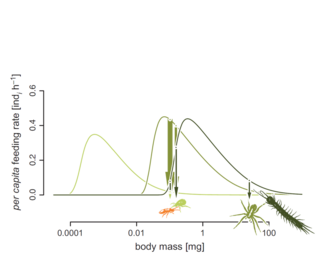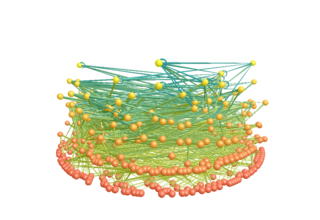Predator-prey interactions and trophic networks
Predator-prey interactions and trophic networks
The earth's ecosystems comprise millions of species that are engaged in billions of interactions. The organization (who is feeding on whom) and the strength of these feeding interactions are critically important for community stability and maintaining biodiversity. However, the enormous number of interactions renders systematic empirical measurements of their strengths impossible thus limiting our abilities to understand the structure, dynamics and stability of natural trophic networks.

How can we obtain a generalized and predictive understanding of interactions between species?
Our primary approach to understanding predator-prey interaction strengths is to focus on constraints by their body masses. We found systematic effects of body masses on feeding rates and functional response parameter (Rall et al. 2012, Kalinkat et al. 2013). The resulting non-random distributions of interaction strengths across species pairs yield a high system stability (Heckmann et al. 2012). Together, these findings show how body masses determine the structure, dynamics and stability of trophic networks in nature. Our current research comprises constraints on species-coexistence patterns in microbial networks, effects of space (habitat size) on interaction strengths and population dynamics and forecasting ecological dynamics.

What are the consequences of climate warming for species' interactions and trophic networks?
In systematic laboratory experiments, we analyzed the increase in consumer feeding rates relative to their metabolism (Vucic-Pestic et al. 2011, Lang et al. 2012). In contrast to prior expectations, we found that the relatively weaker increase in feeding rates stabilizes population oscillations at the risk of consumer starvation (Fussmann et al. 2014). Surprisingly, these destabilizing warming effects can be buffered by nutrient enrichment (Binzer et al. 2016). In ongoing research projects, we are addressing how global change affects interaction strengths and ecosystem functioning.
Binzer, A. et al. 2016. Interactive effects of warming, eutrophication and size structure: impacts on biodiversity and food-web structure. - Glob. Change Biol. 22: 220–227.
Fussmann, K. E. et al. 2014. Ecological stability in response to warming. - Nat. Clim. Change 4: 206–210.
Heckmann, L. et al. 2012. Interactive effects of body-size structure and adaptive foraging on food-web stability. - Ecol. Lett. 15: 243–250.
Kalinkat, G. et al. 2013. Body masses, functional responses and predator–prey stability. - Ecol. Lett. 16: 1126–1134.
Lang, B. et al. 2012. Warming effects on consumption and intraspecific interference competition depend on predator metabolism. - J. Anim. Ecol. 81: 516–523.
Rall, B. C. et al. 2012. Universal temperature and body-mass scaling of feeding rates. - Philos. Trans. R. Soc. B Biol. Sci. 367: 2923–2934.
Vucic-Pestic, O. et al. 2011. Warming up the system: higher predator feeding rates but lower energetic efficiencies. - Glob. Change Biol. 17: 1301–1310.
